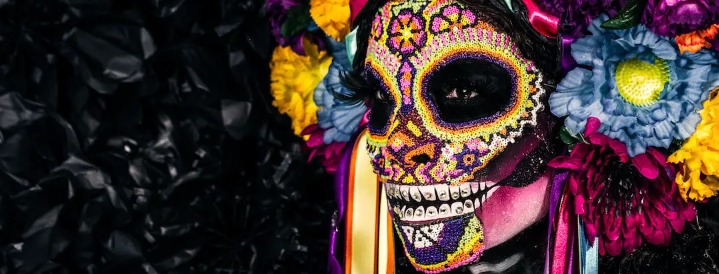La Catrina & Day of the Dead
Catrinas are elegantly dressed skeletal figures, often depicted as women wearing extravagant hats, flowing dresses, and adorned with delicate accessories. They serve as a powerful reminder that death is an inherent part of life and should be embraced with joy, laughter, and a sense of humor. These whimsical and enchanting figures are not intended to be scary or morbid, but rather to celebrate the cycle of life and the memories of those who have departed.
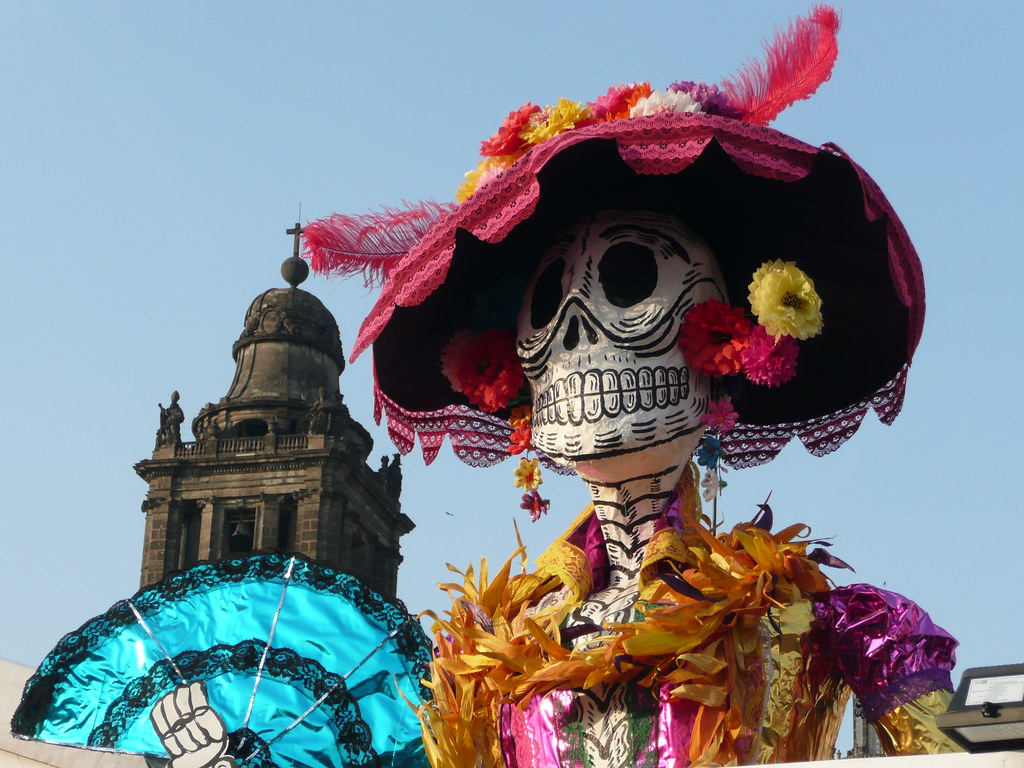
In Mexican culture, death is seen as a natural part of the human experience, and the Day of the Dead is a time to remember and honor the deceased. Families gather at cemeteries to clean and decorate the graves of their loved ones, creating beautiful altars known as ofrendas. These altars are adorned with marigolds, candles, photographs, favorite foods, and personal belongings of the deceased, all meant to welcome their spirits back to the earthly realm for a brief visit.
Who created la catrina?
La Catrina was originally created by Jose Guadalupe Posada and later named and painted dressed up by Diego Rivera in one of his murals. It became an iconic figure in Mexican culture representing death and the way Mexicans face it.
La Catrina History
The origins of Catrinas can be traced back to the early 20th century, during a time when Mexico was going through significant social and political changes. It was in this era that the renowned Mexican artist, Jose Guadalupe Posada, first introduced the concept of La Calavera Catrina.
The skeleton lady was created by lithographer and printer Jose Guadalupe Posada on zinc etching around 1910 as an illustration for a Calavera.
The leaflet was named by Posada La Calavera Garbancera, describing a person who was ashamed of his Indian origins and dressed imitating the French style while wearing lots of makeup to make his skin look whiter.
In 1948 Diego Rivera who considered Posada his artistic father, made the mural Sunday Evening’s Dream in which he represented 400 years of Mexican history. In this masterpiece, Rivera depicts the end of an era destroyed by the Revolution war, and the beginning of a new cycle as a modern and more equitable nation.
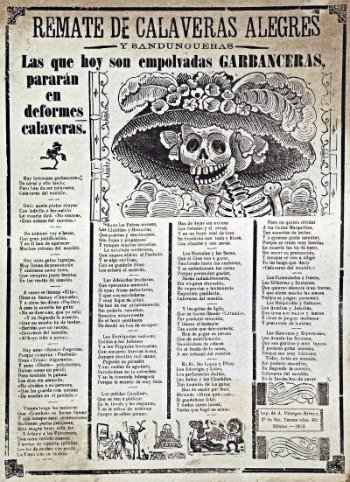
Initially, Catrinas were meant to be a humorous reflection of the privileged class, highlighting the irony of their obsession with material possessions in the face of death. However, over time, Catrinas evolved into a symbol of both celebration and remembrance, embodying the belief that death is an integral part of life.
Rivera not only painted the Garbancera dressed up but also named her “La Catrina”. Catrin(a) is slang for elegant or well-dressed and it refers to rich people. Thanks to Diego Rivera the skeleton lady became an iconic image in Mexico’s culture and is traditionally used in the Day of the Dead, especially in urban celebrations. Posada and Rivera captured in this figure the comfortable and intimate relationship Mexicans have with death.
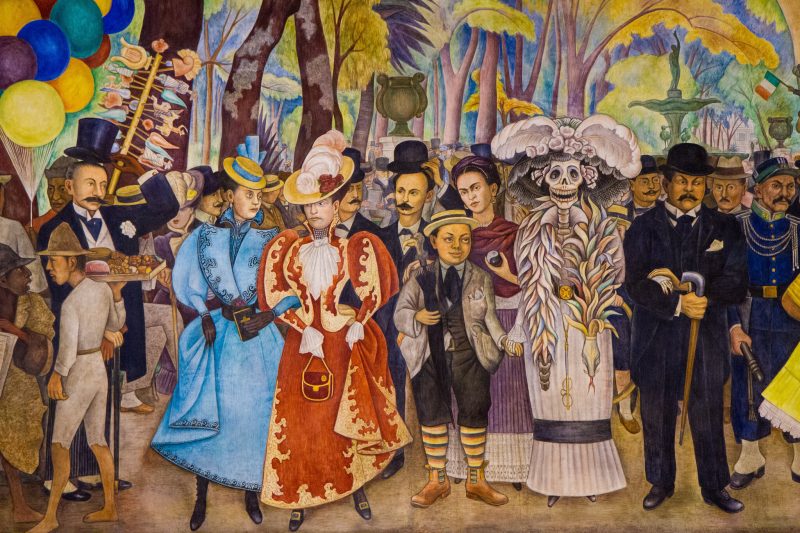
In recent years, Catrinas have gained international recognition and popularity, with their striking imagery appearing in art exhibits, fashion shows, and even Hollywood productions. Their allure lies not only in their aesthetic appeal but also in the rich cultural heritage and symbolism they embody.
La Catrina and Folk Art
Catrinas, the elegant and intricately adorned skeletal figures that have become synonymous with the Day of the Dead celebrations in Mexico, are more than just beautifully crafted works of art. They hold a deep symbolism and represent a profound cultural significance.

At first glance, the Catrinas may appear morbid or macabre, with their skeletal features and colorful attire. However, their purpose goes beyond death and embraces the concept of celebrating life. These vibrant figures serve as a reminder that death is an inevitable part of the human experience and that it should be embraced and celebrated rather than feared.
In 1982 sculptor and painter Juan Torres from Morelia, Michoacán reproduced the skeleton lady in clay for the first time.
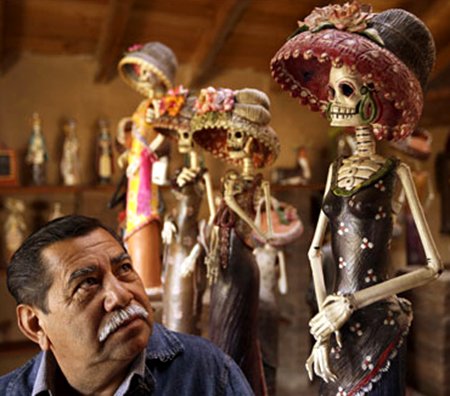
Torres established his workshop in Capula, a town near Morelia with a pottery tradition dating from pre-colonial times. People from Capula soon learned from the painter and so they created a folk art style that has been imitated in many other pottery centers in the country.
Over time, the Catrinas have evolved to become a symbol of Mexican identity and a representation of the country’s rich cultural heritage. They are now associated with the Day of the Dead, a holiday that honors and remembers deceased loved ones. During this time, families gather to create altars adorned with marigolds, candles, and photographs of their departed relatives. The Catrinas, with their elaborate costumes and cheerful expressions, are often placed on these altars as a way to welcome and honor the spirits of the deceased.
The calavera garbancera has been depicted in many other Mexican folk art styles such as the Oaxacan wood carvings, papier mache sculptures, mayolica pottery and black clay.
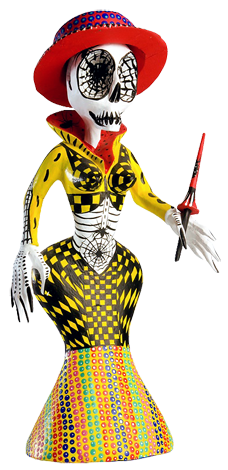
Beyond their association with death, the Catrinas also embody notions of femininity, resilience, and beauty. They are often depicted wearing elegant dresses, extravagant hats, and vibrant jewelry, reflecting the Mexican tradition of celebrating the beauty and strength of women.
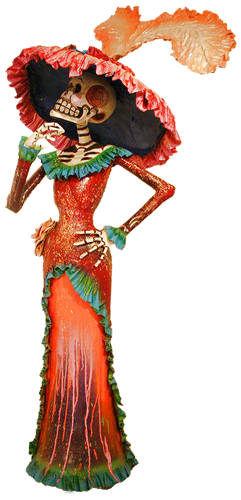
The Catrinas serve as a powerful reminder that life is finite and should be cherished. They encourage us to embrace our mortality and to live each day to the fullest. In Mexican culture, death is not viewed as an end, but as a continuation of the cycle of life. The Catrinas embody this belief, reminding us that even in death, there is beauty, joy, and celebration.
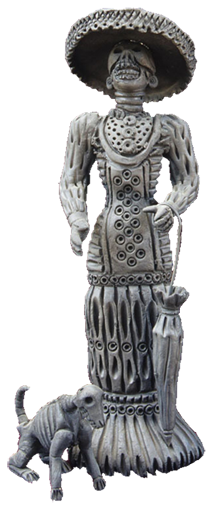
The world of Mexican Catrinas is a captivating realm of artistry and craftsmanship that beautifully celebrates life and death. These iconic skeletal figures, adorned in elegant attire and elaborate accessories, have become synonymous with Mexican culture and the Day of the Dead festivities.
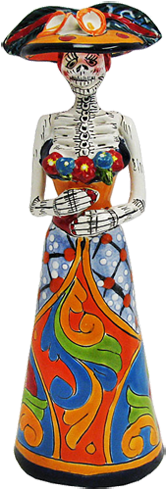
In recent years, the image of Frida Kahlo and her self-portraits have become a subject in Mexican folk art due to the popularity the Hollywood movies gave her in the USA and Canada.
The use of Frida’s image has also been combined with the Garbancera, creating an item often called the Frida Kahlo Catrina depicting a skeleton woman resembling Frida’s self-portraits.
Types and Styles of Mexican Catrinas
When it comes to purchasing Mexican Catrinas, you will find a variety of types and styles available, ranging from traditional to modern interpretations. Traditional Catrinas often feature elegant dresses, intricate hairstyles, and painted faces with a touch of skeletal features, capturing the essence of the holiday and paying homage to the ancestors.
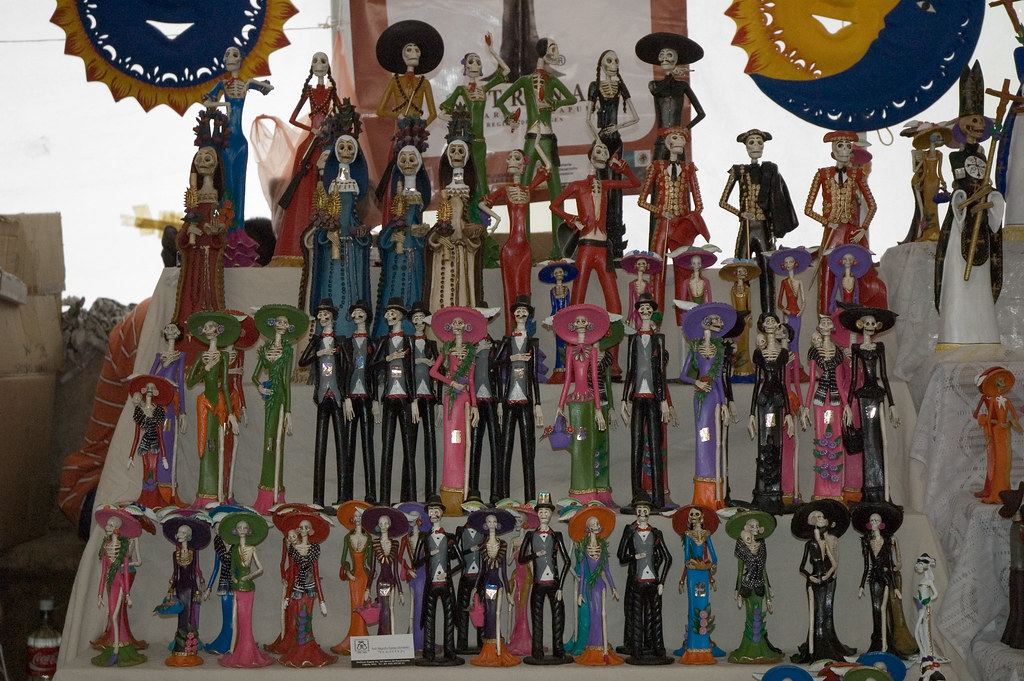
Modern Interpretations
For those seeking a more contemporary twist, modern interpretations of Catrinas showcase innovative designs that blend traditional elements with contemporary aesthetics. These Catrinas may feature bold colors, unconventional clothing styles, and unique accessories, offering a fresh take on this beloved cultural symbol.
Artisan Markets
To explore the best places to buy Mexican Catrinas, you can start by visiting local artisan markets and craft fairs in Mexico, particularly in regions known for their rich artistic heritage such as Oaxaca, Mexico City, and Guanajuato. These markets often showcase the work of talented artisans who specialize in creating Catrinas, allowing you to admire their craftsmanship firsthand and purchase directly from the artists themselves.
If you’re unable to travel to Mexico, don’t worry! There are also online platforms and e-commerce websites that specialize in Mexican folk art and offer a wide range of Catrinas for sale. These platforms provide a convenient way to explore various styles and types of Catrinas, ensuring that you’ll find the perfect one to embrace the spirit of Dia de los Muertos in your own home.
Creating your own Catrina
Creating your own Catrina artwork or costume is a wonderful way to immerse yourself in the enchanting world of Mexican Catrinas. These elegant and elaborate skeletal figures, with their vibrant colors and intricate designs, are a symbol of celebrating life and death in Mexican culture.
If you’re feeling inspired to craft your own Catrina-inspired masterpiece, there are plenty of DIY ideas and tips to help you get started. One of the most important aspects of creating a Catrina is capturing the essence of elegance and beauty while incorporating the iconic elements of these captivating figures.
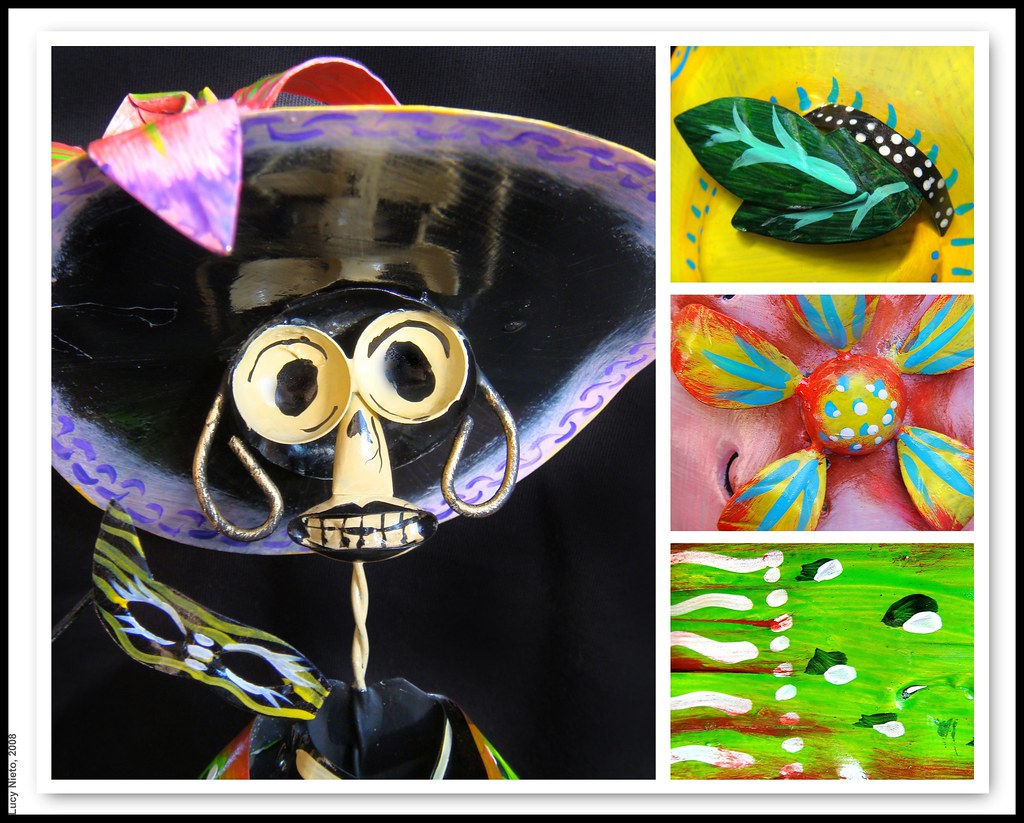
You can use materials like paper mache, clay, or even repurposed items to give your creation a unique touch. Start by sketching out your design and thinking about the details that will make your Catrina come to life. From the delicate facial features to the elaborate headdress and flowing dress, every aspect of your artwork should reflect the rich tradition and artistry behind the Catrina.
If you’re more inclined to bring Catrina to life through a costume, there are endless possibilities for creating your own Catrina-inspired attire. Start by selecting a dress or outfit that embodies the elegance and vibrancy of the Catrina. Add intricate lace details, colorful ribbons, and ornate accessories to complete the look. To truly embrace the spirit of the Catrina, don’t forget to incorporate the iconic skull face paint and elaborate headpiece adorned with flowers and feathers.
Catrinas Beyond Mexico
The allure of Mexican Catrinas extends far beyond the borders of Mexico. This captivating cultural icon has gained global recognition and has been adopted by various cultures and communities around the world. The Catrina represents a beautiful fusion of art, fashion, and tradition, making it an enchanting symbol that resonates with people from all walks of life.
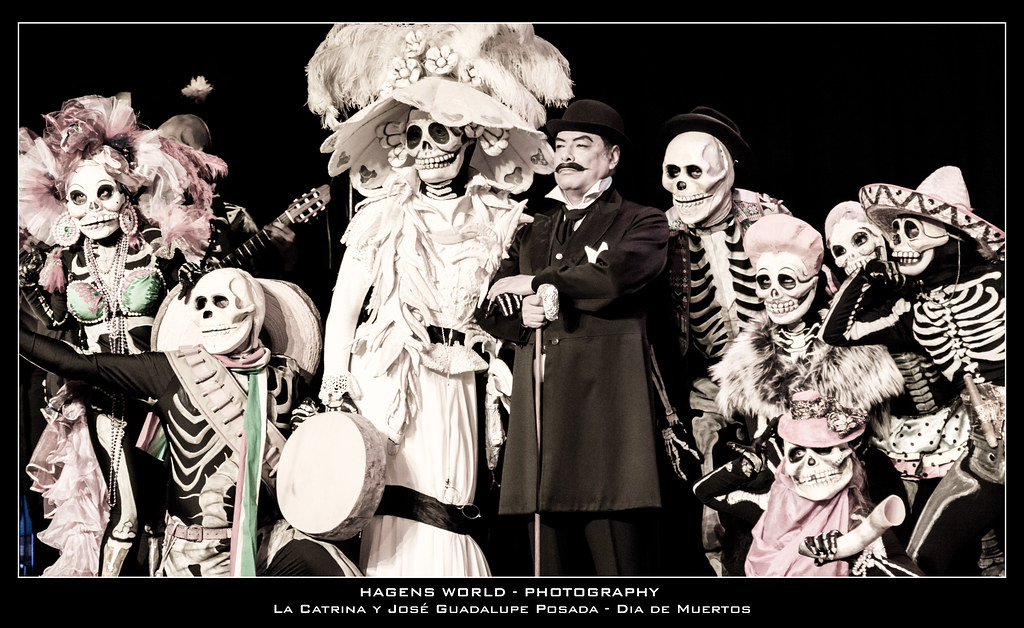
The international fascination with Catrinas can be attributed to their striking visual appeal. With their intricately designed skull-like faces adorned with vibrant makeup and ornate headpieces, Catrinas have become a popular choice for Halloween costumes, Day of the Dead celebrations, and various themed events. The elegance and beauty of Catrina-inspired fashion have captured the imagination of people worldwide, who seek to embody the spirit of this celebrated figure.
Catrinas have transcended cultural boundaries, becoming a symbol of inclusivity and unity. Artists, designers, and enthusiasts from diverse backgrounds have embraced the Catrina as a means of cultural appreciation and expression. From intricate artwork and sculptures to modern fashion designs, Catrinas have found a place in contemporary art, fashion, and even home decor.
Final Word
We hope you enjoyed exploring the enchanting world of Mexican Catrinas with us. These iconic skeletal figures have captivated people around the world, representing a unique blend of celebration, art, and cultural significance. Through their vibrant colors, intricate designs, and poignant symbolism, Catrinas invite us to embrace life and honor the cycle of death. As we conclude this journey, we encourage you to delve deeper into the rich traditions and stories behind these captivating figures. May they continue to inspire and remind us to celebrate and cherish every moment of our lives.
